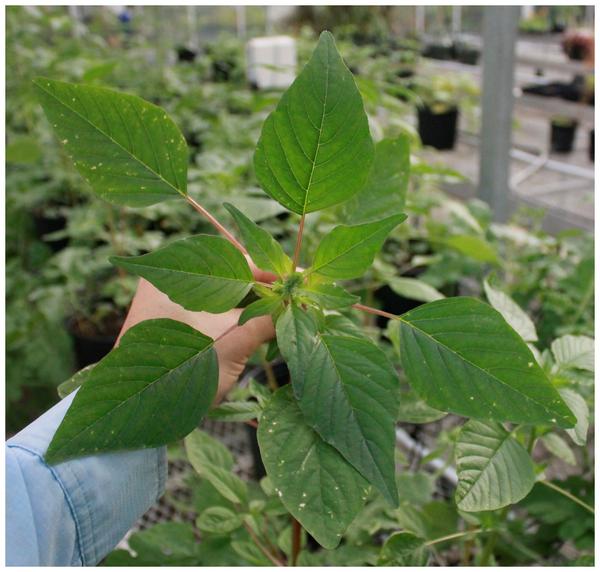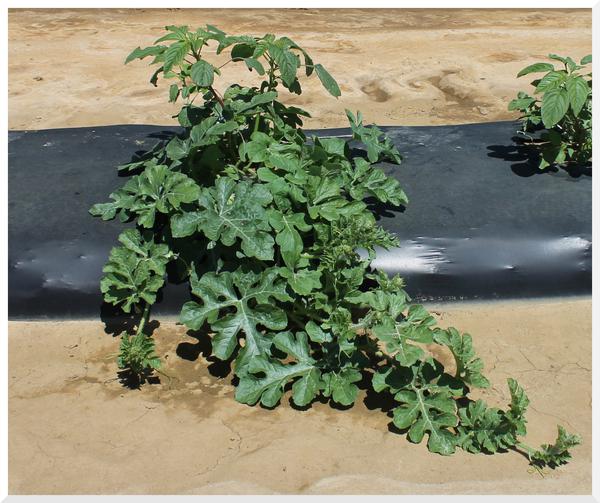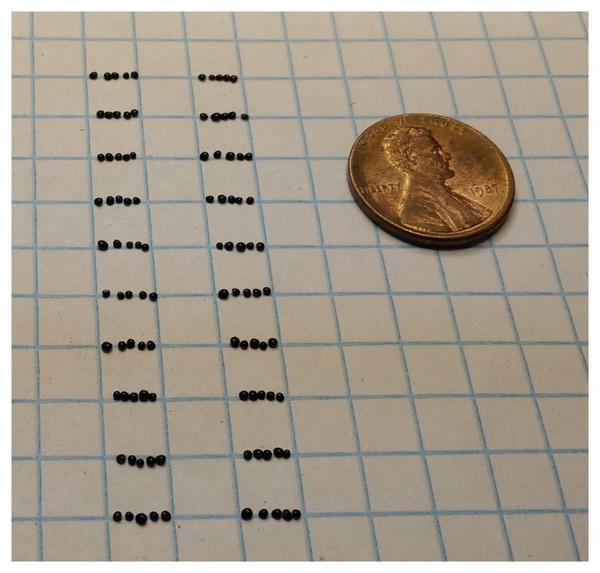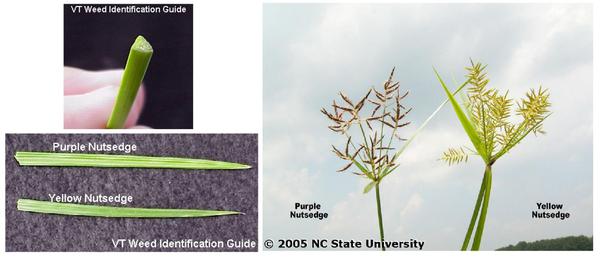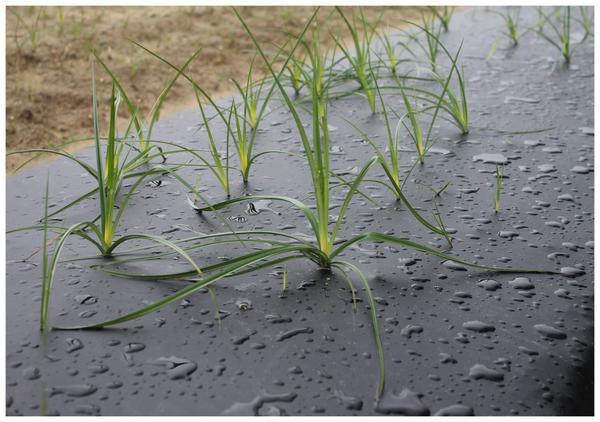Watermelon is a high value crop, and production practices that maximize yield and fruit quality should be implemented. Weeds are a common pest that, if left uncontrolled, can reduce watermelon yield and fruit quality and interfere with harvest (Adkins et al. 2010; Monks and Schultheis 1998). Many problematic weed species commonly occur in watermelon fields, including annual grass and broadleaf species. Palmer amaranth (Amaranthus palmeri), redroot pigweed (A. retroflexus), yellow nutsedge (Cyperus esculentus), and purple nutsedge (C. rotundus) are among the most common and troublesome weeds in southern watermelon fields (Webster 2010; Van Wychen 2016). An effective weed management strategy should include knowledge of weed biology, preventing the introduction of new weeds, diligent monitoring of fields, and implementation of a diverse weed control strategy that includes mechanical and cultural control and the use of herbicides or fumigants.
Weed Biology
Palmer amaranth and redroot pigweed are small-seeded summer annual weeds of the Amaranthaceae family (Figure 1). Palmer amaranth is a tall, erect, branching summer annual that commonly grows 6 to 8 feet tall and occasionally exceeds 10 feet (Sellers et al. 2003; Norsworthy et al. 2008) (Figure 2 and Figure 3). Palmer amaranth is dioecious, meaning it exists as separate male and female plants. One female Palmer amaranth can produce from 200,000 to 600,000 seeds (Keeley et al. 1987; Sellers et al. 2003) (Figure 4). Redroot pigweed is monoecious, meaning that both male and female flowers are produced on the same plant. A single redroot pigweed can produce as many as 290,000 seeds (Sellers et al. 2003). Resistance to herbicides has been documented in both species. Globally, some populations of Palmer amaranth and redroot pigweed have been reported as resistant to six and three herbicide modes of action (MOAs), respectively (Heap 2024). In North Carolina, Palmer amaranth has documented resistance to glyphosate, glufosinate, HPPD inhibitors, PSII inhibitors and ALS inhibitors (Heap 2024). Yellow nutsedge and purple nutsedge are creeping perennial monocots of the Cyperaceae family. Nutsedge species have narrow, linear leaf blades and are superficially similar to grasses, but nutsedges have triangular stems (Figure 5). Nutsedge reproduces and spreads primarily via dispersal of tubers. Mature tubers can produce new shoots, allowing nutsedge to spread and infest new areas of a field during tillage or cultivation. Tubers can also be inadvertently carried by farm machinery to other fields, thus starting new infestations over long distances. After one year, a single purple nutsedge tuber can grow to cover an area of 238 sq ft and produce 3,440 shoots (Webster 2005a). In one year, a yellow nutsedge tuber can grow to cover an area of 34 sq ft and can produce 1,700 to 6,900 new shoots (Ransom et al. 2009; Tumbleson and Kommedahl 1961). Both purple and yellow nutsedge are capable of penetrating polyethylene mulch, suggesting that even plastic mulching is not sufficient to control nutsedge infestations (Webster 2005b) (Figure 6). Purple nutsedge growth is stimulated by the increased temperatures under black plastic mulch compared to a field with no mulch (Webster 2005a). Nutsedges are not controlled by graminicides (ACCase inhibitors). There are few herbicide options for nutsedge control.
Monitor Fields and Maintain Records
The first step in weed management is to collect and review information about weeds in each field. To develop an effective weed management strategy, identify the weed species present in a field and where they are likely to occur. Proper identification of weed species will determine which weed control options will be effective. Seasonal records on weed species and distribution within a field will help you decide where to implement additional weed control measures or where to avoid measures that could exacerbate the problem. By monitoring weed species numbers each year, the weed management program can be adjusted to increase weed control effectiveness specific to the weeds present.
Implement a Diverse Weed Control Strategy
Not only are there few herbicides to control sedges, watermelon is also sensitive to many herbicides that could be used to manage a broad spectrum of weeds. Due to the limited choices of herbicides for watermelon, weed control in watermelon requires a diverse weed control strategy including mechanical, cultural, and chemical methods.
Mechanical Control
Mechanical control includes tillage, hoeing, and hand weeding, all of which physically remove or destroy developing or germinating weedy plants. Depth of tillage is an important consideration. Tillage depth should be set as shallow as possible without reducing weed control. Shallow tillage will unearth fewer weed seeds than deep tillage. With a perennial weed species (for example, purple or yellow nutsedge), a single tillage event may only spread the weed across the field, causing more problems than no tillage at all. Research suggests that biweekly tillage would disrupt growth of both purple and yellow nutsedge, but long-term control would require supplementary control practices (Bangarwa et al. 2012). Once watermelon vines have extended into row middles, tillage is no longer an option.
Hoeing and hand weeding are alternative forms of mechanical weed control in watermelon. These options require manual labor and will cost more on a per acre basis than tillage. Manual weed control is best implemented in areas of the field where tillage is not possible, such as within rows or in row middles after watermelon vines have run together. Hand weeding and hoeing are excellent options for removing late-season weeds that have escaped herbicide application. Late-season hand weeding can prevent weeds from depositing seeds in the soil, an important preventive measure for future growing seasons. Growers are advised to maintain a zero-tolerance threshold for Palmer amaranth in fields, particularly when herbicide resistance is a concern (Norsworthy et al. 2014). The zero-tolerance threshold stops new deposits to the soil seedbank, which is particularly important in preventing the expansion of herbicide-resistant weed populations that limit chemical control options and may limit yields in subsequent years. If Palmer amaranth seeds remain near the soil surface (about a half inch deep), the number of viable seed drops by 91 percent within three years, reducing the number of seeds present in future seasons (Sosnoskie et al. 2013). Diligent weed management is necessary to prevent future outbreaks, and limiting seed production can make weed control easier and more effective in subsequent growing seasons.
Cultural Control
Cultural control creates an environment that favors crop development and limits growth and development of weeds. Cultural weed-control practices include transplanting rather than direct-seeding, proper fertilizer application, irrigation, use of cover crops to reduce weed populations, and plastic mulching. Cultural control is generally beneficial regardless of the weed species that are present. Some cultural practices are more effective than others, depending on the weed species.
Watermelon may be direct-seeded or transplanted as three- to four-leaf plug plants. Typically, triploid (seedless) watermelon are transplanted due to germination requirements and high seed cost. Transplanted watermelon develop more rapidly than direct-seeded watermelon. Early crop development shortens the time from transplanting until canopy closure, when emerging weeds no longer compete with the crop and reduce yield. Use of transplants rather than direct-seeded watermelon increases the early season competitiveness of the watermelon and may suppress weed emergence due to more rapid canopy development, particularly in rows.
Fertilizer applications may also affect weed populations, which compete for nutrients in the soil. Fertilizer can be broadcast over the field, applied in bands over watermelon rows, or applied via drip irrigation. Broadcast applications of fertilizer deliver nutrients to the entire field, including row middles. Watermelon roots do not reach into row middles until late in the season; therefore, broadcasting fertilizer early in the season fertilizes mostly the weeds that are growing in the row middles. Banded applications place the fertilizer close to watermelon roots, giving advantage to the crop, although competition still occurs with weeds growing in the row. The best option is to apply fertilizer via drip irrigation so the fertilizer is delivered directly to the root zone of the crop, reducing the amount of nutrients available to weeds.
Polyethylene mulch can be used to suppress weed seed germination in rows. Raised plastic beds with drip irrigation prevent emergence of weeds in rows and allow application of irrigation and fertilizer to the crop root zone. Black polyethylene mulch prevents light from reaching small seeds, and it prevents germinating seed from emerging in rows. Be aware that tears or small rips in the plastic will allow weed emergence through the plastic, including around planting holes (Figure 2). Further, purple and yellow nutsedge can penetrate plastic mulches as early as six days after plastic has been laid (Patterson 1998; Webster 2005b) (Figure 6). Besides plastic mulch, winter cover crops or straw in row middles can provide weed control between rows and reduce weed establishment in the field (Webster et al. 2013; Wilhoit and Coolong 2013).
The use of cover crops for weed control in specialty crops (for example, vegetables, small fruits, and fruit trees) has been studied over many decades, more in some crops than others. There are summer cover crops and winter cover crops. The latter can work well with watermelons. The two main strategies for incorporating winter cover crops to control weeds in commercial watermelon production are strip-till and no-till cover crop management. In both systems, winter annual grasses like cereal rye or winter wheat are planted in the fall to provide soil cover in the winter. These grasses produce large amounts of biomass that physically suppress weeds during the subsequent spring and early summer watermelon cropping season (Teasdale et al. 2007). Cereal rye and wheat also produce natural chemicals that inhibit small-seeded weeds. The physical and chemical weed suppression from these cover crops can last for about one month, depending on the amount of biomass produced in a particular site. In the strip-till system, the cover crop is mowed and tilled into the soil in strips or rows to allow for plasticulture raised beds to be laid using standard bedding equipment. In this system, the cover crop is left standing in the row middles as a windbreak to protect young transplants from wind damage and desiccation during the early transplant stage. Later, the cover crop stubble can be rolled down in the row middles to provide a straw mat that reduces weed emergence and gives the watermelon vines a place to run. In the no-till system, the entire cover crop biomass is rolled down and left on the soil surface to physically suppress weeds. Typically, a roller, roller-crimper, or herbicide—or some combination of the three—is used to kill the cover crop and create the smooth mat into which watermelons are transplanted directly (Ashford and Reeves 2003; Balkcom et al. 2007). The no-till system is also typically combined with an application of preemergence (PRE) or postemergence (POST) herbicides to fully suppress weeds until the vines achieve canopy closure (Hand et al. 2018). In organic production systems, cover crops are often an important component of weed management due to the lack of chemical control measures approved for organic production. The use of winter cover crops is also an important soil conservation strategy, particularly on the sandy soils commonly used for watermelon production.
Some growers have elected to use grafted watermelon, though its adoption is still limited in the United States (Kubota et al. 2008). Grafting is a technique that connects the shoot of one plant (the scion) to the rootstock of another cultivar or species. The scion is a watermelon cultivar selected for high yield or high quality fruit, while the rootstock is selected for disease resistance or tolerance to abiotic stresses such as drought or cold (Keinath and Hassell 2013; Miguel et al. 2004; Yetisir et al. 2006). Field trials in North Carolina determined that the same weed management practices for nongrafted watermelon will work for grafted watermelon (Bertucci et al. 2019). However, results also indicated that grafting will not provide yield benefits in the absence of disease pressure from soilborne pathogens (Bertucci et al. 2018). For more information on watermelon grafting, contact the authors or visit the Vegetable Grafting Research-Based Information Portal.
Herbicides
Few herbicides are registered for watermelon. Restrictions for use are based on crop planting method, use of polyethylene mulch, timing of application, and where applications are made within the field. Some preplant applications may be broadcast above polyethylene mulch (for example, glyphosate and terbacil); but to avoid crop injury, a minimum of a half inch of rainfall or irrigation must wash the herbicide from the plastic prior to planting. Herbicides also may be registered for preplant, PRE, or POST applications. Finally, herbicides may be registered for use as a fumigant or for broadcast-, banded-, or hooded-sprayer application. Due to crop sensitivity, only two herbicides are registered for POST broadcast applications in watermelon. Clethodim (Select®) and sethoxydim (Poast®) are registered for application over emerged watermelon to control annual and perennial grass species. The remaining POST herbicide options must be applied as a post-directed application to row middles in order to avoid crop injury.
Most herbicides registered for use in watermelon are nonselective and may injure crops if applied improperly (Dittmar et al. 2008; Grey et al. 2000; Mitchem et al. 1997). Thus, proper calibration of sprayers is critical. Check the sprayer pressure, tractor speed, and flow rate (gallons per minute) from each nozzle. The output from each nozzle must be uniform; damaged nozzle tips must be replaced. All applications should be made at the recommended rate and according to label instructions.
Grasses
Common grasses in southern watermelon fields include large crabgrass (Digitaria sanguinalis) and goosegrass (Eleusine indica) (Webster 2010). Fortunately, several PRE and POST herbicides are available for control of these annual grasses (Table 1). Be aware that ACCase herbicides (clethodim and sethoxydim) can take several days to produce symptoms in treated weeds. The first symptom on a treated grass is a brown, mushy growing point. Because the growing point of a grass is hidden beneath the sheath, you will have to pull on the youngest emerging leaf to see the affected area. Symptoms then progress to discolored purple leaves followed by plant death.
| Common name (trade name) |
Timing and placement to the crop |
Weed growth stage |
Weeds controlled/ suppressed |
|---|---|---|---|
| Bensulide (Prefar®)
|
BS[1], BT
|
PRE
|
AG, BL
|
| Carfentrazone (Aim®)
|
BT, POST-RM
|
POST
|
BL
|
| Clethodim (Select Max®)
|
POST
|
POST
|
AG
|
| Clomazone (Command®)
|
AS, BT
|
PRE
|
AG, BL
|
| Clomazone +
Ethalfluralin (Strategy™)
|
AS, BT, POST-RM
|
PRE
|
AG, BL
|
| Ethalfluralin (Curbit®)
|
AS, BT, POST-RM
|
PRE
|
AG, BL
|
| Fomesafen (Reflex®[2])
|
AS, BT
|
PRE, POST
|
BL, PS
|
| Glyphosate (Roundup®)
|
BS, BT, POST-RM
|
POST
|
AG, BL, PS
|
| Halosulfuron (Sandea®)
|
AS, BT, POST-RM
|
PRE, POST
|
AG, BL, PS
|
| Imazosulfuron (League®)
|
POST-RM
|
PRE, POST
|
AG, BL, PS
|
| Paraquat (Gramoxone®)
|
BS, BT
|
POST
|
AG, BL
|
| Pyraflufen ethyl (ET®)
|
BS
|
POST
|
AG
|
| Sethoxydim (Poast®)
|
POST
|
POST
|
AG
|
| Terbacil (Sinbar®)
|
AS, BT, POST-RM
|
PRE
|
AG, BL
|
| Trifluralin (Treflan®)
|
POST-RM
|
PRE
|
AG, BL
|
- PPI – Preplant incorporated ↲
- Fomesafen (Reflex) has a 24(c) registration. Please be aware that rotational crop restrictions exist with fomesafen applications. Growers must have a copy of the supplemental label, which is available at the Kelly Solutions website. ↲
BS—Before seeding; AS—After seeding, before emergence; PRE—Preemergence; POST—Postemergence; POST-RM—Postemergence row middles only; AG—Annual grasses; BL—Broadleaves; PS—Perennial sedges ↲
Because of the limited chemical options, control of broadleaf and sedge weed species is more challenging than control of grass species. Following are examples of weed control options for Palmer amaranth, redroot pigweed, purple nutsedge, and yellow nutsedge.
Palmer Amaranth and Redroot Pigweed (And Most Other Pigweed Species)
- Apply nonselective burndown herbicides such as glyphosate or paraquat (Gramoxone®), then till to prepare the planting beds. Alternatively, till the field and allow weeds to germinate, then burn down weed seedlings with nonselective herbicides. This sequence will reduce the in-season weed population significantly.
- Form beds and apply halosulfuron-methyl (Sandea®), 0.5 to 0.75 oz/acre; terbacil (Sinbar®), 2 to 4 oz/acre; or metam sodium (Vapam®), varying rates, below polyethylene mulch. Vapam® has a 14- to 21-day preplant interval (up to 30 days in some environments). Sandea® has a seven-day preplant interval.
- Use black polyethylene mulch and the herbicides below the plastic to effectively control pigweed species in the beds.
- Till the row middles to control small pigweed seedlings. Apply trifluralin (Treflan®), 1 to 2 pt/acre, to row middles after the final tillage event. Trifluralin has a 60-day preharvest interval so apply it within 10 to 12 days after transplanting.
- For POST options for row middles, apply glyphosate with a hooded sprayer, shielded sprayer, or wick bar. You can also apply carfentrazone-ethyl (Aim®) at 1 to 2 oz/acre with a hooded sprayer.
Note: If Palmer amaranth or other pigweed species are present after herbicide application and you are concerned that they will reduce fruit yield and quality, you should hand weed. Any female Palmer amaranth plants that escape this herbicide regime should be hand weeded and removed from the field to eliminate seed deposition and to prevent development of herbicide-resistant populations.
Purple and Yellow Nutsedge
- Apply a preplant application of metam sodium (Vapam®), the best option, at 75 GPA to control the nutsedge. Rates range from 15.7 to 31.5 lb/acre depending on soil conditions. Fourteen to 21 days must pass before transplanting watermelons (up to 30 days, depending on environmental conditions).
- Apply halosulfuron-methyl (Sandea®) after bed formation, but before laying plastic, at a rate of 0.5 to 0.75 oz/acre. Seven days must pass before planting. Glyphosate or paraquat (Gramoxone®) can be applied preplant to kill emerged weeds.
- Before purple and yellow nutsedge can penetrate through polyethylene mulch, use PRE or preplant applications of Vapam® or Sandea®.
- Apply an early-season POST application of imazosulfuron (League®) at 4 to 6.4 oz/acre or halosulfuron-methyl (Sandea®) at 0.5 to 1 oz/acre if nutsedge has emerged in row middles. Either of these applications must occur early in the season, due to a 48-day and 57-day preharvest interval for League® and Sandea®, respectively. Neither product should be allowed to contact the melon crop or the plastic.
- Apply glyphosate to row middles on emerged nutsedge; you must use a hooded or shielded sprayer to avoid contact with the crop. Follow label instructions.
Note: A single tillage is not recommended for control of mature nutsedge. Tillage will kill foliar parts of the nutsedge, but it will spread tubers across a field. Glyphosate is a better option and has been demonstrated to reduce tuber production of both purple and yellow nutsedge (Webster et al. 2008).
Disclaimer: The use of specific product names is for the convenience of readers. This does not represent endorsement of a particular product or company. No conflicts of interest exist for authors. This document was prepared in a collaborative effort between researchers at North Carolina State University and the University of Arkansas.
Resources
Adkins J.I., W.M. Stall, B.M. Santos, S.M. Olson, and J.A. Ferrell. “Critical Period of Interference Between American Black Nightshade and Triploid Watermelon.” Weed Technology 24, no. 3 (2010): 397-400. ↲
Ashford, D.L. and D.W. Reeves. “Use of a Mechanical Roller-crimper as an Alternative Kill Method for Cover Crops.” American Journal of Alternative Agriculture 18, no. 1 (2003): 37-45. ↲
Balkcom K., H. Schomberg, W. Reeves, and A. Clark. “Managing Cover Crops in Conservation Tillage Systems.” In Managing Cover Crops Profitably, edited by A. Clark, 44-61. College Park, MD: Sustainable Agriculture Research & Education (SARE), 2007. ↲
Bangarwa, S.K., J. K. Norsworthy, and E.E. Gbur. “Effects of Shoot Clipping — Soil Disturbance Frequency and Tuber Size on Aboveground and Belowground Growth of Purple and Yellow Nutsedge (Cyperus rotundus and Cyperus esculentus).” Weed Technology 26, no. 4 (2012): 813-817. ↲
Bertucci, M.B., K.M. Jennings, D.W. Monks, J.R. Schultheis, F.J. Louws, D.L. Jordan, and C. Brownie. “Critical Period for Weed Control in Grafted and Nongrafted Watermelon Grown in Plasticulture.” Weed Science 67, no. 2 (2019): 221-228. ↲
Bertucci, M.B., K.M. Jennings, D.W. Monks, J.R. Schultheis, P. Perkins-Veazie, F.J. Louws, and D.L. Jordan. “Early Season Growth, Yield, and Fruit Quality of Standard and Mini Watermelon Grafted onto Several Commercially Available Cucurbit Rootstocks.” HortTechnology 28, no. 4 (2018): 459-469. ↲
Dittmar, P.J., D.W. Monks, J.R. Schultheis, and K.M. Jennings. “Effects of Postemergence and Postemergence-directed Halosulfuron on Triploid Watermelon (Citrullus lanatus).” Weed Technology 22, no. 3 (2008): 467-471. ↲
Grey, T.L., D.C. Bridges, and D.S. NeSmith. “Tolerance of Cucurbits to the Herbicides Clomazone, Ethalfluralin and Pendimethalin. II. Watermelon.” HortScience 35, no. 4 (2000): 637-641. ↲
Hand, L.C., W.G. Foshee, T.A. Monday, D.E. Wells, and D.P. Delaney. “Preemergence Herbicides Applied Pre- and Postcrimp in a Rye Cover Crop System for Control of Escape Weeds in Watermelon.” HortTechnology 28, no. 2 (2018): 117-120. ↲
Heap, I. The International Survey of Herbicide Resistant Weeds (online). Accessed Monday, October 7, 2024. ↲
Keeley, P.E., C.H. Carter, and R.J. Thullen. “Influence of Planting Date on Growth of Palmer Amaranth (Amaranthus palmeri).” Weed Science 35, no. 2 (1987): 199-204. ↲
Keinath, A.P. and R.L. Hassell. “Control of Fusarium Wilt of Watermelon by Grafting onto Bottlegourd or Interspecific Hybrid Squash Despite Colonization of the Rootstocks by Fusarium oxysporum.” Plant Disease 98, no. 2 (2013): 255-266. ↲
Kubota, C., M.A. McClure, N. Kokalis-Burelle, M.G. Bausher, and E.N. Rosskopf. “Vegetable Grafting: History, Use, and Current Technology Status in North America.” HortScience 43, no. 6 (2008): 1664-1669. ↲
Miguel, A., J. Maroto, A. Bautista, C. Baixauli, V. Cebolla, B. Pascual, S. Lopez, and J. Guardiola. “The Grafting of Triploid Watermelon is an Advantageous Alternative to Soil Fumigation by Methyl Bromide for Control of Fusarium Wilt.” Scientia Horticulturae 103, no. 1 (2004): 9-17. ↲
Mitchem, W.E., D.W. Monks, and R.J. Mills. “Response of Transplanted Watermelon (Citrullus lanatus) to Ethalfluralin Applied PPI, PRE, and POST.” Weed Technology 11, no. 1 (1997): 88-91. ↲
Monks, D.W. and J.R. Schultheis. “Critical Weed-free Period for Large Crabgrass (Digitaria sanguinalis) in Transplanted Watermelon (Citrullus lanatus).” Weed Science 46, no. 5 (1998): 530-532. ↲
Norsworthy, J.K., M.J. Oliveira, P. Jha, M. Malik, J.K. Buckelew, K.M. Jennings, and D.W. Monks. “Palmer Amaranth and Large Crabgrass Growth with Plasticulture-grown Bell Pepper.” Weed Technology 22, no. 2 (2008): 296-302 ↲
Norsworthy, J.K., G. Griffith, T. Griffin, M. Bagavathiannan, and E.E. Gbur. “In-field Movement of Glyphosate-resistant Palmer Amaranth (Amaranthus palmeri) and its Impact on Cotton Lint Yield: Evidence Supporting a Zero-threshold Strategy.” Weed Science 62, no. 2 (2014): 237-249. ↲
Patterson, D.T. “Suppression of Purple Nutsedge (Cyperus rotundus) with Polyethylene Film Mulch.” Weed Technology 12, no. 2 (1998): 275-280. ↲
Ransom, C.V., C.A. Rice, and C.C. “Yellow Nutsedge (Cyperus esculentus) Growth and Reproduction in Response to Nitrogen and Irrigation.” Weed Science 57, no. 1 (2009): 21-25. ↲
Sellers, B.A., R.J. Smeda, W.G. Johnson, J.A. Kendig, and M.R. Ellersieck. “Comparative Growth of Six Amaranthus Species in Missouri.” Weed Science 51, no. 3 (2003): 329-333. ↲
Sosnoskie, L.M., T.M. Webster, and A.S. Culpepper. “Glyphosate Resistance Does Not Affect Palmer Amaranth (Amaranthus palmeri) Seedbank Longevity.” Weed Science 61, no. 2 (2013): 283-288. ↲
Teasdale, J.R., L.O. Brandsaeter, A. Calegari, and F. Skora Neto. “Cover Crops and Weed Management.” In Non-Chemical Weed Management: Principles, Concepts and Technology, edited by M.K. Upadhyaya and R.E. Blackshaw, 49-64. Wallingford, UK: CAB International, 2007. ↲
Tumbleson, M.E. and T. Kommedahl. “Reproductive Potential of Cyperus esculentus by Tubers.” Weeds 9, no. 4 (1961): 646-653. ↲
Webster, T.M. “Patch Expansion of Purple Nutsedge (Cyperus rotundus) and Yellow Nutsedge (Cyperus esculentus) with and without Polyethylene Mulch.” Weed Science 53, no. 6 (2005a): 839-845. ↲
Webster, T.M. “Mulch Type Affects Growth and Tuber Production of Yellow Nutsedge (Cyperus esculentus) and Purple Nutsedge (Cyperus rotundus).” Weed Science 53, no. 6 (2005b): 834-838. ↲
Webster, T.M., T.L. Grey, J.W. Davis, and A.S. Culpepper. “Glyphosate Hinders Purple Nutsedge (Cyperus rotundus) and Yellow Nutsedge (Cyperus esculentus) Tuber Production.” Weed Science 56, no. 5 (2008): 735-742. ↲
Webster, T.M. 2010. “Weed Survey — Southern States 2010. Vegetable, Fruit and Nut Crops Subsection.” In Proceedings, Southern Weed Society, v. 63., Little Rock, Arkansas, 2010, 246-257. ↲
Webster, T., B. Scully, T. Grey, and A. Culpepper. “Winter Cover Crops Influence Amaranthus Palmeri Establishment.” Crop Protection 52 (2013): 130-135. ↲
Wilhoit, J. and T. Coolong. “Mulching with Large Round Bales Between Plastic-covered Beds Using a Newly Developed Offset Round-bale Unroller for Weed Control.” HortTechnology 23, no. 4 (2013): 511-516. ↲
Yetisir, H., M.E. Çaliskan, S. Soylu, and M. Sakar. “Some Physiological and Growth Responses of Watermelon [Citrullus lanatus (Thunb.) Matsum. and Nakai] Grafted onto Lagenaria siceraria to Flooding.” Environmental and Experimental Botany 58, nos. 1-3 (2006): 1-8 ↲
Publication date: Nov. 26, 2024
AG-879
There is an alternate English language version of this document here: Control de Malezas en en el Cultivo de Sandía
Recommendations for the use of agricultural chemicals are included in this publication as a convenience to the reader. The use of brand names and any mention or listing of commercial products or services in this publication does not imply endorsement by NC State University or N.C. A&T State University nor discrimination against similar products or services not mentioned. Individuals who use agricultural chemicals are responsible for ensuring that the intended use complies with current regulations and conforms to the product label. Be sure to obtain current information about usage regulations and examine a current product label before applying any chemical. For assistance, contact your local N.C. Cooperative Extension county center.
N.C. Cooperative Extension prohibits discrimination and harassment regardless of age, color, disability, family and marital status, gender identity, national origin, political beliefs, race, religion, sex (including pregnancy), sexual orientation and veteran status.

